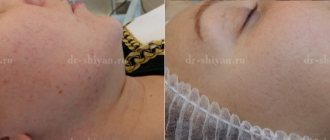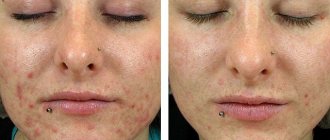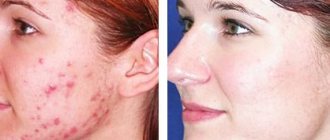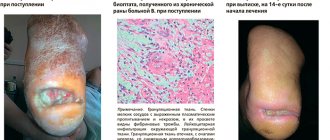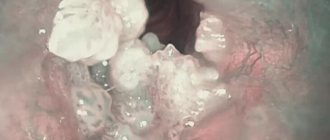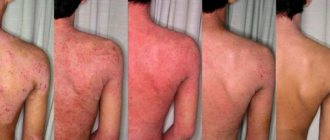Diana-35
Low-dose monophasic contraceptive with antiandrogenic effect. Contains cyproterone acetate (2 mg) and ethinyl estradiol (0.035 mg). The contraceptive effect is achieved through a combination of factors, the most important of which are inhibition of ovulation and changes in the viscosity of cervical mucus. Diane-35 also changes the structure of the endometrium - it turns out to be unprepared for implantation of the egg and, in the event of fertilization, it will not be able to attach.
Cyproterone acetate, which is the main active substance of the drug, inhibits the production of androgens (male sex hormones), which are produced in excess quantities in the female body. Thus, Diane-35 treats diseases caused by increased levels of androgens in the blood or increased sensitivity to these hormones. Under the influence of Diane-35, the activity of the sebaceous glands, which plays an important role in the occurrence of acne, acne and seborrhea (oily skin) of the face and head, decreases. After 3-4 months of therapy, acne becomes significantly smaller or disappears completely. Excessive oiliness in hair and skin disappears even earlier. Hair loss, which often accompanies seborrhea, is also reduced.
Another therapeutic effect of Diane-35 is that it reduces the manifestations of mild forms of hirsutism (increased male pattern hair growth) in women of reproductive age on the success of treatment - a similar result can be achieved after several months of continuous use. Like other combined oral contraceptives, Diane-35 reduces the risk of anemia and pain before and during menstruation.
Diane-35 can be recommended by a gynecologist to patients who experience increased manifestations of androgenization. External signs of this condition: acne (acne), seborrhea, inflamed red acne, alopecia (hair loss), hirsutism (excessive hair growth on the face and body).
Contraindications to taking Diane-35 are:
- diseases associated with thrombosis (currently or in history);
- disorders of the cardiovascular system (angina pectoris, myocardial infarction, chest pain);
- stroke;
- diabetes mellitus with vascular complications;
- jaundice or severe forms of liver disease;
- current or history of breast or genital cancer;
- benign or malignant neoplasm in the liver currently or in history;
- vaginal bleeding, the cause of which has not been identified.
If any of the listed conditions appear for the first time while taking Diane-35, you should immediately stop therapy and consult a doctor. To prevent unwanted pregnancy, you need to use barrier methods (suppositories, pastes, condoms). The drug should not be taken during pregnancy and breastfeeding.
During a conversation with a gynecologist who is selecting a contraceptive for you, be sure to tell him the following information:
- do you smoke;
- Your weight;
- Do you suffer from high blood pressure, how often, how much does the pressure increase;
- do you suffer from migraines, severe headaches, how often;
- do you have a tendency to diabetes;
- you or your relatives have been diagnosed with heart valve damage or serious heart rhythm disturbances, inflammation of the veins (phlebitis of the superficial veins), thrombosis, myocardial infarction, stroke, epilepsy, liver or gallbladder disease.
If you take Diane-35 for a long period, you should be especially attentive to annual preventive examinations with a gynecologist. An extraordinary visit to the gynecologist should be made in situations where:
- you notice local lumps in the mammary gland;
- you are prescribed a serious course of treatment;
- a long period of limited mobility is predicted (for example, with a broken leg);
- there is atypical heavy vaginal bleeding;
- no menstrual bleeding for two cycles in a row;
- signs of thrombosis appear;
- Headaches occur more often than before;
- severe pain in the legs, swelling.
Possible side effects that are most likely to occur in the first 2-3 months of taking the drug:
- headache;
- engorgement of the mammary glands, pain in the chest, discharge from the mammary glands;
- changes in libido (sexual desire);
- frequent depression, bad mood, irritability;
- intolerance to contact lenses;
- nausea, vomiting;
- changes in the thickness and structure of vaginal discharge;
- fluid retention in the body, swelling;
- change in body weight.
Reception scheme
The Diane-35 package contains 21 tablets. One tablet is taken every day - it is advisable to do it at the same time. On the packaging, the tablets are marked according to the days of the week. Accordingly, if you start the pack, for example, on Wednesday, you need to take the first tablet from the cell labeled “Wednesday”. Next, you need to take the pills, focusing on the direction of the arrow.
When all the tablets from the package have been taken, a week-long break begins. During the break, as a rule, menstrual-like bleeding occurs (withdrawal bleeding). In most cases, it begins 2-3 days after taking the last Diane-35 tablet. After a week's break, you begin taking pills from the next package - regardless of whether the bleeding has stopped or not. It turns out that a new pack always starts on the same day of the week, and bleeding also occurs on approximately the same day of the week.
Start of taking Diane-35
- If no hormonal contraceptive was used in the previous month, Diane-35 should be started on the first day of the cycle, that is, on the first day of menstrual bleeding. You can start taking it on days 2-5 of the menstrual cycle, but in this case it is necessary to additionally use a barrier method of contraception for a week.
- When switching from other combined oral contraceptives, Diane-35 should be taken the next day after the last tablet of the previous package was taken - that is, without a break in taking the pill. If the previous drug contains 28 tablets, you can start taking Diane-35 the next day after taking the last active tablet. You can start taking it later, but in no case later than the next day after the usual one-week break in taking it (for preparations containing 21 tablets) or after taking the last inactive tablet (for preparations containing 28 tablets per package).
- When switching from a mini-pill, you can start taking Diane-35 on any day. It is advisable to take the first Diane-35 tablet at the same time as the mini-pill tablets. It is recommended to additionally use a barrier method of contraception (for example, a condom) for a week.
- When switching from an injectable contraceptive, Diane-35 should be taken on the day of the next injection. During the first 7 days of taking the pills, you must also use an additional barrier method of contraception (for example, a condom).
- When switching from an implant, Diane-35 should be taken on the day of implant removal. During the first 7 days of taking the pills, you must also use an additional barrier method of contraception (for example, a condom).
After giving birth, it is recommended to wait until the first natural menstruation, and only then start taking Diane-35.
After a spontaneous miscarriage or abortion in the first trimester of pregnancy, your doctor may recommend that you start taking it immediately. If this condition is met, there is no need for additional contraceptive protection.
For the purpose of contraception, as well as to achieve an antiandrogenic effect, Diane-35 can be taken for a long period of time. When treating androgen-dependent conditions, the duration of use is determined by the severity of the disease. After the symptoms disappear, it is recommended to take Diane-35 for at least another 3-4 months. If a relapse occurs, the course of treatment with Diane-35 can be repeated.
What to do if you forget to take a pill.
If the delay in taking the next pill is less than 12 hours, the contraceptive effect of Diane-35 is maintained. You need to take the pill immediately. The next tablet is taken at the usual time.
If the missed dose is more than 12 hours, the contraceptive reliability of Diane-35 is reduced. And each subsequent omission reduces contraceptive reliability more and more. The risk of pregnancy is especially high if you miss a pill at the beginning or end of the pack. In such situations, the sequence of actions depends on how many tablets are missed and which tablets are missed in order.
If more than one tablet from the package is forgotten, you should stop taking the drug and consult your doctor.
If one pill is missed, it must be taken immediately, even if this means taking two pills at the same time. Then the drug is taken according to the usual schedule.
If you miss taking a pill and the pack runs out in less than 7 days (third week of taking), you should start taking a new pack as soon as the current pack runs out, without taking a week's break. There will be no withdrawal bleeding, but spotting or breakthrough bleeding may occur while taking tablets from the second package. In this case, during the week after missing a pill, you must use additional contraception.
The absence of menstruation during the week-long break indicates a possible pregnancy. Get a test or ultrasound before you start taking pills from a new pack.
If vomiting occurs 4 hours after taking the Diane-35 tablet, this may reduce the contraceptive effect. In this situation, you should act in the same way as if you missed a pill.
Contraindications
If a woman has suffered malignant tumors of the genital organs or breast in the past, the use of the drug is prohibited (as in the case of a similar diagnosis in the present tense). Pregnant and breastfeeding women should also avoid treating acne this way. If you have diseases of the endocrine system, and especially if you are prone to thrombosis or vascular pathologies, you should avoid taking such medications, because they often led to a fatal outcome due to a general unfavorable background.
If the source of a girl’s acne was a disruption in the functioning of hormones, then Diane 35 is really effective.
But an integrated approach to acne treatment is necessary in any case. The use of cleansing and antiseptic cosmetics for the skin will emphasize the results of taking the drug. [carousel-horizontal-posts-content-slider]
Does it help or not?
The drug Diane 35 is a hormonal pill intended for the treatment of gynecological diseases and the prevention of unwanted pregnancy. It is prescribed for the treatment of diseases of the reproductive system associated with hormonal imbalance. The use of this drug as a remedy for acne is possible only if it occurs due to hormonal imbalance.
The instructions for the drug Diane 35 mention the possibility of using this drug for the treatment of acne. It contains 2 mg of cyproterone acetate, which is a hormonal substance with antiandrogenic properties. A woman’s body contains male hormones, of course in smaller quantities than a man’s, but it is their increase that provokes increased sebum production and excessive hair growth on the body. The antiandrogen binds to the receptors of these hormones and reduces their production.
The drug should be taken after consulting a doctor; it is prescribed for a period of up to 24 months.
According to reviews, the drug not only effectively copes with the appearance of acne, but also makes the skin smoother and the hair thicker and more beautiful.
What is acne?
Probably every girl can answer this question - pimples are small bumps on the skin, red or white, purulent, or are they large purple pimples that can spoil the impression of even the most beautiful face. But what is acne from a medical point of view, why does it torment some, despite all the measures taken, while others did not encounter this problem even in adolescence. [sam_pro id=”0_7″ codes=”true”][sam_pro id=”1_31″ codes=”true”] Acne occurs due to disruption of the sweat and sebaceous glands, which are located in large numbers in the upper layers of the epidermis. Their appearance signals a disruption in the functioning of the body as a whole, and if the cause of their occurrence is not eliminated, no anti-acne medications will help.

